The Koi angelfish is a miraculous variety that has gold-orange, black, and white coloration on its body. Those are beautiful freshwater cichlids that belong to the Cichlidae family. Because of their stunning body colorations, graceful movements, and body shape, Koi Angelfish is well suited for a community tank. Small fish have a spot beneath their eye. This spot spreads across the head area with time and gets yellow.
Do you know Koi Angel can change their colors according to the situation? The following article will help you to know exciting information about Koi Angelfish. Definitely, Koi Angelfish will be your favorite pet in the future.
What is Angelfish?
Jump To
- 1 What is Angelfish?
- 2 What is Koi Angelfish?
- 3 The appearance of the Koi Angelfish
- 4 Types of Koi Angelfish
- 5 Koi Angelfish care
- 6 Tank cleaning procedure
- 7 Feed requirement & Feeding frequency
- 8 How many Koi Angelfish can you have in a tank?
- 9 How big do Koi Angelfish get?
- 10 Are Koi Angelfish aggressive?
- 11 Koi Angelfish lifespan?
- 12 Koi Angelfish male-female difference?
- 13 Koi Angelfish tank mates?
- 14 How to breed Koi Angelfish at home?
- 15 Koi Angelfish price
- 16 Common diseases of Koi Angelfish
- 17 Related questions
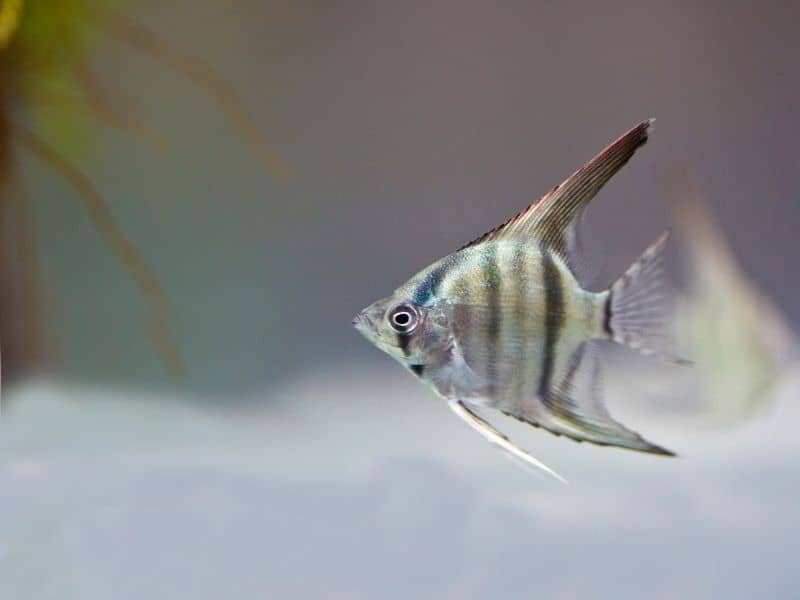
Angelfish’s native habitats are situated in tropical South America associated with the Amazon River system. There are three known species of Angel. They are Pterophyllum scalare, Pterophyllum altum, and Pterophyllum dumerili. But the most common species is Pterophyllum scalare that people rear in their aquariums. In the wild habitats, they are inhibited in calm water that has a slow flow rate. They are associated with overhanging vegetation areas where trees have fallen into the river.
The wild varieties of Angelfish are rare in the Ornamental industry and most of the ornamental Angelfish are the result of the selective breed. In the wild, Angelfish have a silver color body and vertical black stripes. Moreover, Angelfish have a vertically flattened body. Over the years, farmers tend to produce more attractive varieties for Ornamental purposes. Thus, nowadays Angelfish have many color varieties, scale types, and fin types.
They produce marvelous Angelfish varieties and these fish have amazing features such as veil tails, albino eyes, and attractive color patterns. Generally, Angelfish is easy to breed under normal conditions.
What is Koi Angelfish?
The Koi Angelfish belongs to Pterophyllum scalare species. Koi Angelfish is a manmade hybrid. It is produced through selective breeding and uses mottled gold-orange, white, and black coloration parent fishes.
The appearance of the Koi Angelfish

Koi Angelfish have laterally compressed round bodies. Their dorsal and anal fins are elongated and triangular in shape. This unique diamond body allows them to move and hide easily in a planted tank. Because of the orange-gold patch situated on their head area, they called Koi Angelfish. This Koi name is derived from Koi carp and Koi Angelfish color blotches are similar to the Koi carp. This yellow-gold patch is the best method to distinguish the Koi Angelfish from other Angelfish. According to the random color patches, each specimen has a different appearance.
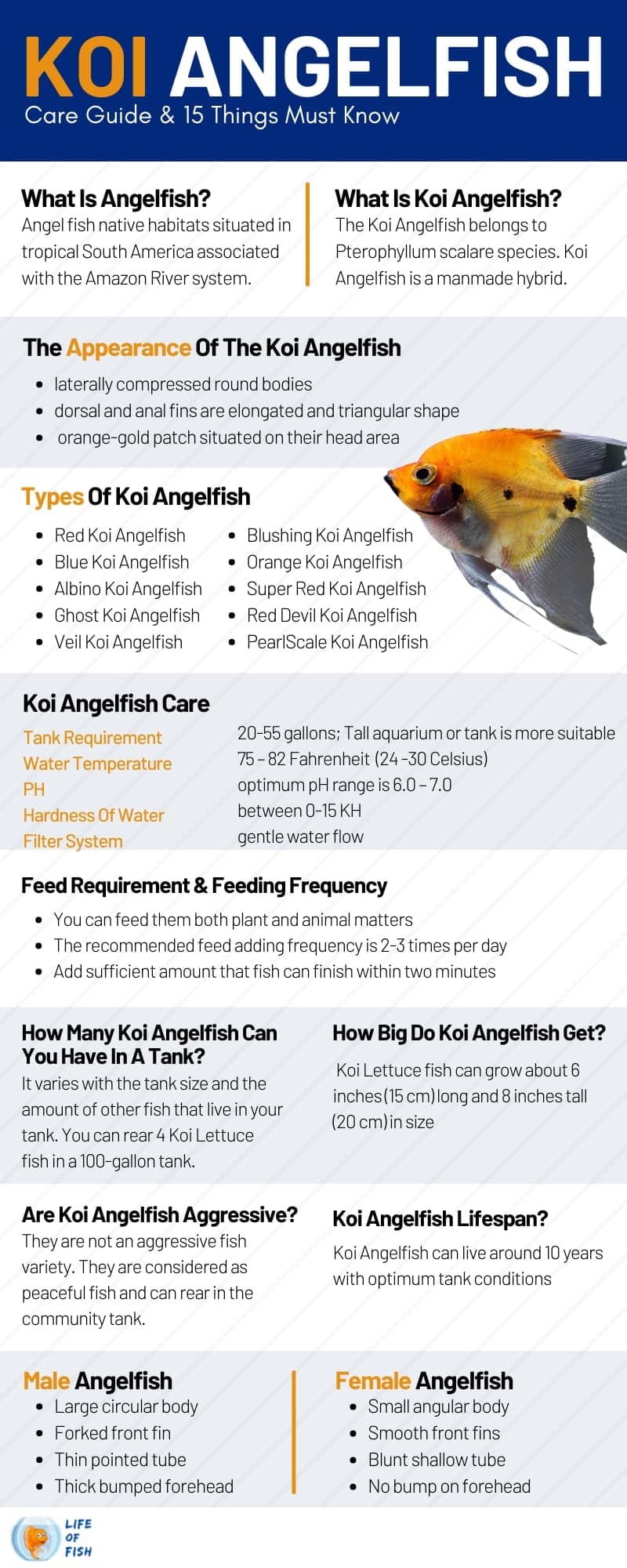
Types of Koi Angelfish
Red Koi Angelfish
It is a crossbreed of blushing Angel and Koi Angel. Most of their body cover with red color scales and have some black and yellow markings on their body. They are very rare and difficult to find.
Blue Koi Angelfish
Their body color is light blue and has several black spots on their body. The head area of the Blue Koi Angelfish is covered with yellow color scales. This variety is rear.
Albino Koi Angelfish
This variety has a unique feature on their eyes. Their eyes are red or pinkish and have a yellow color patch on the head. Albino Koi Angels are the strain of Albino Silver Angelfish and Koi Angelfish which have yellow markings on the head.
Ghost Koi Angelfish
This species is an extremely popular tropic fish due to its beautiful coloration. Ghost Koi Angels have the same body shape. But they do not have much color pigmentation. The entire body of this fish is silver in color. But you can see the gold-yellow color patch on their head area.
Veil Koi Angelfish
This is one of the popular varieties and they are the most beautiful. Their fins are longer than normal goldfish varieties. Koi veil angelfish got this name because its fins look like a bride’s veil. They also have a gold-yellow color patch on their head. If you rear Koi Veil Angelfish, do not decorate the aquarium with ornaments that have sharp edges. Sharp edges can damage the veil of Angelfish. Damage veils can be subject to fungus attraction easily.
Blushing Koi Angelfish
This fish got that name because of their appearance. Their red color gills make this fish blush. These fish have a golden color body with a silver shade. The head area of Blushing Koi Angels covers with the Gold- orange color patch.
Orange Koi Angelfish
This fish’s body covered with light orange color scales and the head area is dark golden orange color.
Super Red Koi Angelfish
This fish is very rare and very expensive in the market. The body covers with super red scales and the head area has a golden color spot.
Red Devil Koi Angelfish
It is a crossbreed of common Angel and Red Koi devil or Super red Koi Angle. Like other varieties, they show mid-aggressive behavior in a community tank. This variety has a yellow color patch on its head. Because of their rareness, their price is high in the market.
PearlScale Koi Angelfish
They got this name because of their scale shape. They have pearl-type scales that are noticeable. These scales like pearls generated as a result of gene mutation. Their scales are malformed and give a noble appearance to them. Like other Koi Angels, they also have a yellow color patch on their head. This variety also can rear in normal tank conditions.
Related: Are Gourami and Cichlids the same? 12 Interesting Facts
Related:
Koi Angelfish care
Koi Angelfish can live more than 10 years in a well-maintained community tank or aquarium. When compared with other tropical community fish varieties, they have a long life span. As a beginner, you can rear a Koi Angelfish with a moderate care level. But like other fish varieties, Koi Angel also has preferable conditions such as temperature, pH, and tank space.
Tank requirement of Koi Angelfish
The minimum requirement is 20 gallons of a tank for live healthy. But if you can provide 55 gallons tank for the pair, it is better. A tall aquarium or tank is more suitable for Koi Angelfish rather than a horizontally wide tank. Generally, Koi Angels have peaceful behaviors and they do not fight with tank mates. Hence, you can add them to the community tank. In the wild habitat, Angelfish like to associate with plants. Thus, you can add some aquatic plants to your aquarium to give it a natural feel.
Water Temperature
Koi Angelfish can survive in water temperatures that are between 75o F – 82o F (24 oC – 30o C). You can install an aquarium heater in your tank to maintain the temperature. Also, you can install an aquarium thermometer in your tank to check water temperature easily.
pH and hardness of water
You should keep Koi Angelfish in slightly acidic freshwater. The optimum pH range is 6.0 – 7.0 for Koi Angelfish. You can use a digital pH meter to check water pH easily. Water hardness should be between 0-15 KH. Tank water should be soft. It means the TDS (Total Dissolved Solids) value is in between 50-100 ppm. If you have hard water, you want to make it soft. To do this you can purchase reverse osmosis (RO) filter. This filter can reduce water hardness by 95% to 99%. But RO filters cause a drop in pH value too.
Filter system
Koi Angelfish prefers aquariums with a gentle water flow. They are very sensitive to water quality parameters. Due to the above reason, you should add a good filter system with gentle water flow to your Koi Angelfish tank. Bio-Wheel filters are highly recommended for the Koi Angelfish tank. You can use Lava rocks to keep nitrates in the ideal range.
Tank cleaning procedure
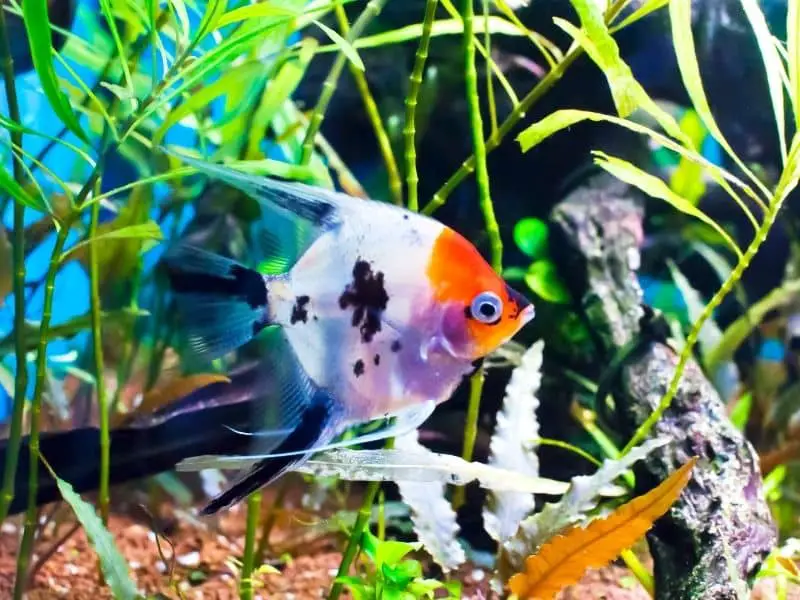
Sudden fluctuation of water quality parameters can kill your favorite pet fish. Therefore, you should change 10% – 25% of tank water every week to maintain water quality at a good level. You can use a siphon pipe or Gravel Cleaner to remove solid waste such as fecal matters, plant debris, and uneaten food particles. If you need to clean the whole tank, please follow the below steps to protect your Koi Angelfish.
- First, you must prepare a separate plastic container with the same old water that fish exist. Because Koi Angelfish are unable to prepare their body suddenly for new water.
- Put your Koi Angelfish into a separate tank by using a fishnet.
- Clean the main tank using portable water
- Then clean driftwood, sands, and stones using portable water
- Clean the tank glasses using algae remover
- Add new water to the aquarium. If you use chlorinated tap water, treat that water using the dechlorinated substance. It should be done before adding that water to the aquarium.
- Add 2-3 tablespoons of sugar to the tank.
- If you have a chemical namely methylene blue. Add 5-6 droplets into the water. Because this helps to heal the injuries or any other damage to fish that happen when you collect the fish.
Place your container in the aquarium for 20 minutes. These 20 minutes help fish to adapt to new water. Because Koi Angelfish are unable to tolerate sudden changes.
Feed requirement & Feeding frequency
The good news is Koi Angels belong to the omnivorous category. Thus, you can feed on them by both plant and animal matters. You can use high-quality formulated feeds, frozen foods, and live food to feed them. You can easily buy formulated food such as fish pellets and flakes from the market. Other than that they prefer live foods such as small insects, blood worms, small shrimps, and small fish.
If you rear Koi Angels with small fish like a guppy, molly, and swordtail, definitely Koi Angelfish will consider their fry fish as food. Further, you can add small vegetable particles such as Lettuce, carrot, and cucumber. The recommended feed adding frequency is 2-3 times per day. Add a sufficient amount that the fish can finish within two minutes. Overfeeding will generate excess waste and uneaten food particles will reduce the water quality of the tank. Hence, remove uneaten food particles immediately.
How many Koi Angelfish can you have in a tank?
It varies with tank size and the amount of other fish that live in your tank. You can rear 4 Koi Lettuce fish in a 100-gallon tank.
How big do Koi Angelfish get?
If the aquarium has enough space and other essential factors are not limited, Koi Lettuce fish can grow about 6 inches (15 cm) long and 8 inches tall (20 cm) in size. You can purchase 1 – 1.5 inches size healthy fish from the market to the rear.
Are Koi Angelfish aggressive?
Generally, cichlid varieties show some aggressiveness. But Koi Angelfish’s behaviors are different from theirs. Koi Angles are not an aggressive fish variety. They are considered peaceful fish and can rear in the community tank. But they try to protect their territory during the spawning period. Because of some disturbance, they will show aggressive behaviors. When they get stressed their golden yellow color spot becomes darker. Hence, you can identify it easily.
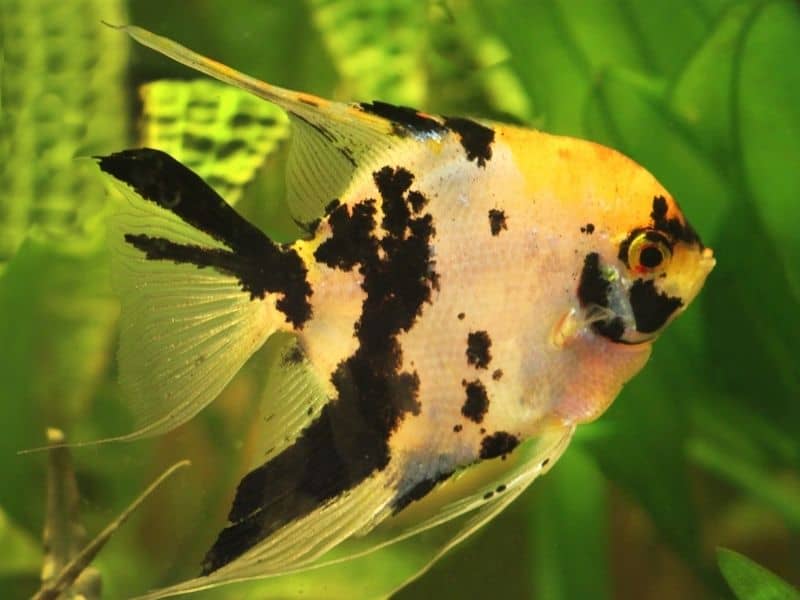
Koi Angelfish lifespan?
Koi Angelfish can live around 10 years with optimum tank conditions. But it can be varied with water quality, predatory fish behaviors, care, and genetic reasons.
Koi Angelfish male-female difference?
Both sexes look similar and you have to inspect carefully to identify their sexes. The major factor is the size of the tube located between the anal fin and ventral fin. Female fish have thicker tubes than male fish. But it can clearly identify during the breeding season. Other than that, mature male fish are a bit larger than female fish. Further, when they are close to spawning, female Koi Angelfish have a round belly than male fish. Female eggs are matured in the belly and hence the belly area gets swollen.
The male fish has a thicker area above its eyes. The pectoral fins of the male fish fork into several pieces. But female fish’s pectoral fins do not have this forking.
| Male Angelfish | Female Angelfish |
| Large circular body | Small angular body |
| Forked front fin | Smooth front fins |
| Thin pointed tube | Blunt shallow tube |
| Thick bumped forehead | No bump on the forehead |
Koi Angelfish tank mates?
Koi angelfish are considered semi-aggressive fish. Generally, they have peaceful behaviors and you can add them to the community tank. You can keep Koi Angelfish with the following fish varieties.
- Catfish
- Swordtails
- Gourami
- Ram fish
- Neon Tetra
- Molly
- Pleco
- Bala shark
- Danios
- Rainbowfish
- Other medium size fish
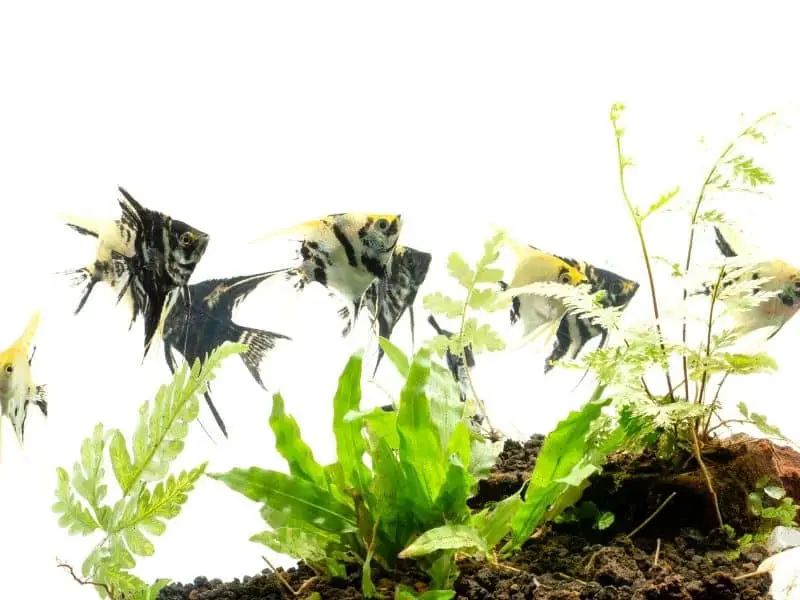
How to breed Koi Angelfish at home?
Koi Angelfish are ready to breed when they are 3.5- 4inches tall. During this season, Koi Angelfish begin to protect their area. If you do not separate them soon into a breeding tank, females stick their eggs on plant leaves, tank substrate, or glass. Thus, you should separate paired fish immediately into the separate breeding tank.
- They pair off when ready to breed, Select Koi Angel pair by considering good coloration, body shape, color patches, and fins. Because parental traits directly transmit to offspring.
- Place the breeding tank in a calm place and cover 4 sides using black paper. If they panic due to environmental factors, they tend to eat their own eggs.
- Install a small sponge filter in the tank. A sponge filter is a better choice for the breeding tank. Because other filters can suck fry fish.
- Separate compatible pair for the separate breeding tank
- Feed them using a high protein diet (above 60% protein) like live or frozen food. Live fish are Blood worms, Mysis shrimp, Glass worms, and Brine shrimp. Normally pellet foods and flakes are not used for fish conditioning.
- Recommended breeding tank size is 1.5 feet in height, 1.5 feet in width, and 1.5 feet in length
- Cover the tank glass using a black color sheet
- Place a clean PVC pipe or tile in the tank. Female fish can attach their eggs to it
- Add methylene blue with 5ppm concentration to protect eggs from fungus
- Male fish will fertilize those eggs
- Add methylene blue few droplets (5ppm) to the tank until the water becomes light blue color. It helps to protect Koi Angle’s eggs from fungus
- After 3-5 days, you can see small fry fish swimming in the tank
- Feed fry with live food such as hatched Artemia /Brine shrimp, Decapped brine shrimp
- You can see fry fish swimming around mother fish at the early stages
Koi Angelfish breed with other angelfish
You can breed Koi angelfish with other Angelfish varieties. But body color, eye color, color patches pattern, body shape, and fin types will depend according to the parent fishes. Thus, you should select suitable parent fishes according to it.
Fry care
In normal conditions, they do not show cannibalism behaviors. Koi Angels have fry care and fry fish swim around the mother Koi Angle. But because of some disturbance of the outer environment, parent fish panic and eat their own fry fish. Thus, you should cover the glass tank using black paper to avoid disturbance.
Koi Angelfish price
They are not very expensive fish. You can purchase 1-2 inch fish for $12 from the market. This price will be a bit with fish size, quality, and season of the year.
Common diseases of Koi Angelfish
If your fish have physical disorders, abnormal swimming patterns, lethargic behaviors, and loss of appetite, it can be a sign of a disease. The main causing agent of diseases are bacteria, viruses, nematodes, and parasites. You should separate infected fish immediately from the main aquarium to prevent the spread of disease. Then you can immediately give correct treatments to your fish to recover them.
| Disease | Causing Agent | Symptom | Treatment |
| Hole in the head | Parasite | Lesions on the head | Rise water temperature to 90 o F Treat aquarium with Metroplex |
| Angelfish Dropsy | Bacteria | Protruding eyes Scales sticking out | Add antibacterial medication to fish food |
| Angelfish Ich/ White spot disease | Suddenly changes in water temperature and stress | Tiny white spots on the body | Rise water temperature to 86o F Add aquarium salt Use Anti parasite medication |
| Fin Rot | Bacteria | Fins look like shredded | Add 5ppm amount of potassium permanganate (KMnO4) Change 50% water every day Again add 5ppm amount of KMnO4 |
| Angelfish velvet disease/Gold dust disease | Parasite | Body covered with gold cysts | Rise water temperature to 82 o F – 86o F Add 2.5 teaspoons of aquarium salts for every gallon of water Add 5ppm amount of Acriflavine to the water |
| Gill Flukes | Parasite | Gill shredded or chewed | Add anti-worm medicine |
Related questions
Koi Angelfish red gills
Koi angles natural gill color varies from pale pinkish to red. Blushing Koi angels got this name because of their red-colored gills. But if the ammonia level of water rises, the gill color can be changed into red. Thus, if your fish gills suddenly become red color, you should check the water quality parameters immediately. Then you can take corrective actions to recover your fish. Some bacteria or parasite infections also can cause the gill to become red in color.
What are the rarest Angelfish?
Freshwater clown angelfish is the rarest fish variety. As a result of rareness, they are considered a premium fish species. They have a brighter color with a metallic shine. The black phantom Angelfish is a very rare variety in the marine ornamental fish industry.
Is Koi Angel like a planted aquarium?
Yes, they are really enjoying planted aquariums that consist of some floating, sun merge and emerging aquatic plants. You can use Anubias species, Java fern, and Water Sprite-like aquatic plants to create their environment. Floating plants are providing shade to the tank. Koi Angelfish also prefer that type of habitat. Other than aquatic plants you can use non-toxic driftwoods. It helps to create an aquatic environment with a more natural feeling. Aquatic plants and driftwoods decorate your tank too.
Do Angelfish attack other fish?
No, in normal conditions they have very peaceful behaviors and are more suitable for the community tank. Because of omnivorous feeding behavior, they eat meat too. If your community tank has fry stages of some fish, Koi Angelfish can be misunderstood as their food. If that fried fish suits their mouth size, definitely they eat them.
What are the smallest Angelfish?
Teardrop angelfish is the smallest Angelfish variety. They are also known as Leopold’s angelfish, Dwarf angelfish, or Roman-nosed angelfish. This species can maximally grow around 5cm. They are native to the Amazon River. they have no pre-dorsal notch and black blotch on the 4th vertical bar. The scientific name of this variety is Pterophyllum leopoldi. Some people misidentify them as P. dumerilii in the aquarium trade. This species is a bit more aggressive than other species.
Are black Angelfish rare?
Yes, they are usually rare and difficult to find compared with other Angelfish varieties. But if you want them to rear, you can find them on the market. But the price will bit high than other Angelfish varieties
Koi Angel and Angelfish compatibility
Yes, both varieties live together in the same tank. Because unlike other cichlid varieties Angelfish has peaceful behaviors. Thus, they suit the community tank. Moreover, they can live with other common types of Angelfish.
Read more : Black neon tetra care guide | 10 things must know
